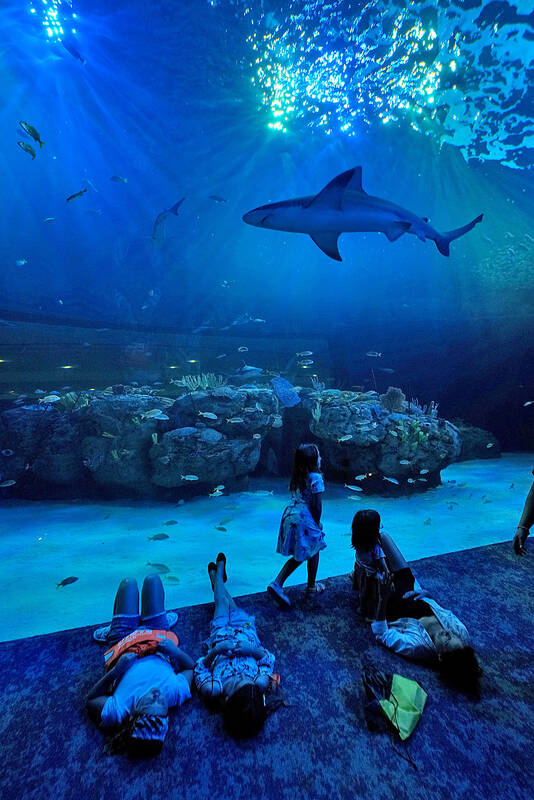Crews used large nets, water-filled containers and box trucks to relocate hundreds of river otters, sea turtles, manatees, penguins and sharks to their new home: Mote Marine Laboratory & Aquarium.
Over the past couple of months, the marine animals were removed from the hard-to-reach island and relocated to a brand new center, where Mote believes they would be able to live in more authentic habitats and make it easier for the public to learn about marine sciences.
The Mote Science Education Aquarium (SEA), just east of Sarasota, is to open to the public today.

Photo: AP
“We have created new authentic habitats for all our species of marine life, including a massive manatee habitat, and homes for some of our newest animals, like the giant Pacific octopus and our penguins,” said Kevin Cooper, vice president for communications and strategic Initiatives at Mote.
“We are also adding more opportunities to learn about marine science for our guests, schoolchildren and adult learners, and offering new opportunities for citizen scientists to participate in marine science through outreach,” he said.
The move was prompted by logistical challenges. It was increasingly challenging for visitors to make their way across the bridges from the mainland to the facility on Sarasota’s City Island where it had been for 45 years. So it made sense to move the aquarium and education centers farther east, while keeping the research portion of the facility on the barrier island.

Photo: AP
In July, Mote closed to the public to prepare so the transition could begin, and in August, crews started moving the animals to the new facility.
Mote educated upwards of 350,000 guests each year and it is expected to double that in the new center, Cooper said.
The new facility cost US$130 million to build.
As each animal has distinct habitat needs, it took time to make sure the habitats at the new Mote SEA facility had the appropriate water chemistry and microbial communities before the animals arrived.
“In the process of that relocation, each different species requires a different type of relocation techniques in order to move them from one facility to another,” said Evan Barniskis, associate vice president for Mote. “When moving sharks and fish, you have to do so in water with plenty of oxygen and filtration on it.”
They moved many of the fish and sharks at night, when there was less traffic. The manatees required air-conditioned box trucks that are specifically designed for manatee relocations. Mote has a team devoted to picking up stranded manatees and to rehabilitate them.
“The otters are a little bit simpler because they have specially designed cages that are kind of similar to those you would put a dog or a cat in,” Barniskis said.
The staff monitored each animal during the journey to the new center. Once at the new site, aquarists and veterinary staff oversaw the acclimation process, as they gradually introduced each animal to the new environment.
“With a transfer operation of this scale, it takes rigorous monitoring, strict protocol adherence, complex coordination and the highest standard of care,” Cooper said. “We consistently monitor each animal for any health or behavioral abnormalities throughout the process and thereafter to ensure successful acclimation.”
“Within this facility, we will have over 400 different species that will be made up of several thousands of individual animals,” Barniskis said.
Mote SEA is dedicated to marine science, education and immersive public experiences, officials said. It contains three STEM teaching labs: biomedical, microbiology and immunology; marine and coastal ecology; and ocean engineering, technology, robotics and sensory development. It will also provide free hands-on experiences for some 70,000 students from Sarasota and Manatee county schools.
Mote, founded in 1955 by Eugenie Clark, also operates coral nurseries in the Florida Keys that are helping restore damaged reefs.
“I think the most important thing we want our visitors to take away is a better understanding of marine science and how Moat Marine Laboratory contributes to expanding the knowledge of the marine environment to the world,” Barniskis said.
“It’s fantastic. Within this aquarium, the Moat Science Education Aquarium, it is our duty to represent that science to the public, to translate it so that the general public can understand exactly what Moat scientists are doing and how we continue to benefit the understanding of the marine environment.”

The Burmese junta has said that detained former leader Aung San Suu Kyi is “in good health,” a day after her son said he has received little information about the 80-year-old’s condition and fears she could die without him knowing. In an interview in Tokyo earlier this week, Kim Aris said he had not heard from his mother in years and believes she is being held incommunicado in the capital, Naypyidaw. Aung San Suu Kyi, a Nobel Peace Prize laureate, was detained after a 2021 military coup that ousted her elected civilian government and sparked a civil war. She is serving a

China yesterday held a low-key memorial ceremony for the 1937 Nanjing Massacre, with Chinese President Xi Jinping (習近平) not attending, despite a diplomatic crisis between Beijing and Tokyo over Taiwan. Beijing has raged at Tokyo since Japanese Prime Minister Sanae Takaichi last month said that a hypothetical Chinese attack on Taiwan could trigger a military response from Japan. China and Japan have long sparred over their painful history. China consistently reminds its people of the 1937 Nanjing Massacre, in which it says Japanese troops killed 300,000 people in what was then its capital. A post-World War II Allied tribunal put the death toll

‘NO AMNESTY’: Tens of thousands of people joined the rally against a bill that would slash the former president’s prison term; President Lula has said he would veto the bill Tens of thousands of Brazilians on Sunday demonstrated against a bill that advanced in Congress this week that would reduce the time former president Jair Bolsonaro spends behind bars following his sentence of more than 27 years for attempting a coup. Protests took place in the capital, Brasilia, and in other major cities across the nation, including Sao Paulo, Florianopolis, Salvador and Recife. On Copacabana’s boardwalk in Rio de Janeiro, crowds composed of left-wing voters chanted “No amnesty” and “Out with Hugo Motta,” a reference to the speaker of the lower house, which approved the bill on Wednesday last week. It is

FALLEN: The nine soldiers who were killed while carrying out combat and engineering tasks in Russia were given the title of Hero of the Democratic People’s Republic of Korea North Korean leader Kim Jong-un attended a welcoming ceremony for an army engineering unit that had returned home after carrying out duties in Russia, North Korean state media KCNA reported on Saturday. In a speech carried by KCNA, Kim praised officers and soldiers of the 528th Regiment of Engineers of the Korean People’s Army (KPA) for “heroic” conduct and “mass heroism” in fulfilling orders issued by the ruling Workers’ Party of Korea during a 120-day overseas deployment. Video footage released by North Korea showed uniformed soldiers disembarking from an aircraft, Kim hugging a soldier seated in a wheelchair, and soldiers and officials